Look no further! This is the traditional brownie recipe you need in your repertoire. This is for those of you who love proper chocolate 🤎They are ridiculously chocolatey. These dark chocolate brownies are intensely decadent, rich and satisfying. Moist, but not completely gooey (still slice-able). Never dry or cake-like. Fudgy, with a chewy crust. An egg-shell thin crackly top. Perfect with a cuppa 🤤
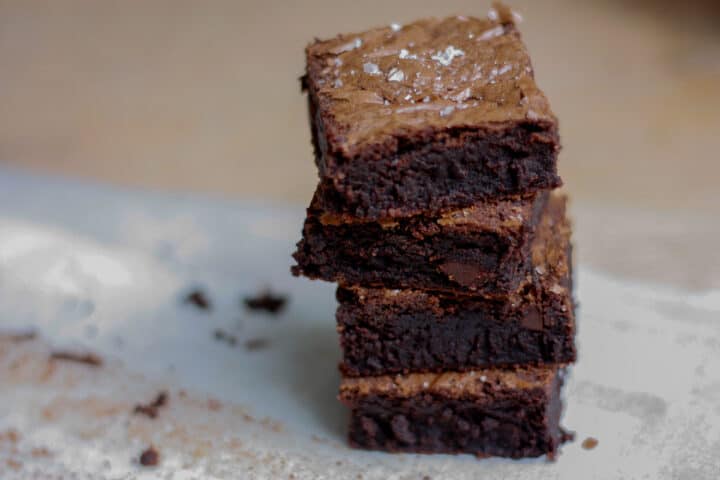
Recipe source
This is a Felicity Cloake recipe. If you're not familiar with her, she has a range of ('Perfect') recipes that are truly tried and tested. She experiments with classic recipes from well-known cooks and chefs so that we don't have to! This recipe for brownies is so good I see no reason to look elsewhere. When you know, you know 🤓
Jump to:
🥘 Ingredients
- chocolate 70% cocoa
- unsalted butter
- golden caster sugar
- eggs
- plain flour
- baking powder
- salt
- unsweetened cocoa powder
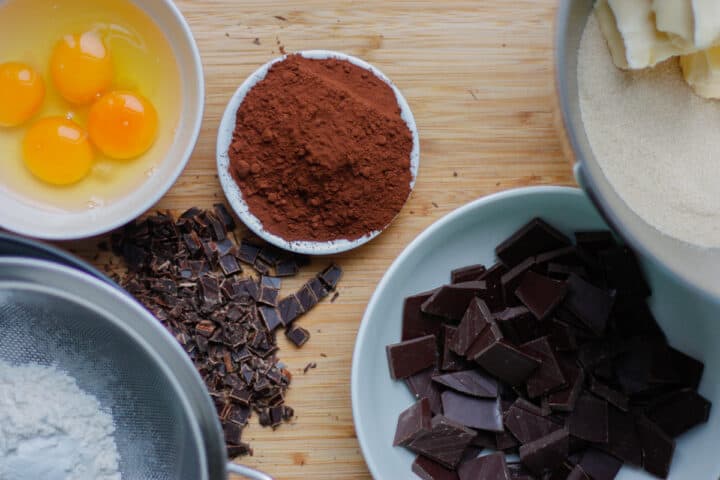
Cocoa powder & chocolate chips & molten chocolate
All the chocolates! 🍫🍫🍫Adding cocoa powder gives rich chocolate flavour without weighing down with extra fat. Hand-chopped chunks of chocolate add extra pockets of gooeyness that are always welcome.
Pantry Staples
If you're like me, you'll always have a stash of dark chocolate in the house. I love Lindt chocolate and buy loads - milk, 70% and 95% cocoa, whenever they're half price.
There's nothing out of the ordinary about the rest of the ingredients. Plain flour, cocoa powder, baking powder, eggs, butter, sugar and salt. I recommend golden caster sugar. If you don't have, white caster sugar will work fine.
Cocoa powder can be Dutch-process or natural here (make sure it's unsweetened!).
❓Instructions
- melt some dark chocolate and roughly chop the rest (homemade choc chips)
- cream butter and sugar. Add eggs. Whip until light and fluffy.
- sift dry ingredients together - flour, baking powder, salt and cocoa powder
- fold melted and chopped chocolate into dry ingredients
- spoon into a lined pan and bake for around 30 minutes, until still slightly gooey in the centre
- cool in a water bath to halt cooking before slicing
Don't use a loose-bottomed cake pan
The batter is thick enough that it wouldn't drip out the bottom but these brownies are delicate. We need to lift the cooked brownies out, rather than push up and out from underneath. And don't even think about inverting the tin. The top, although has a crust, is deceptively delicate. That crust is paper-thin. I once gently lay a palm on the top to see how cool it was, and the crust came away on my hand 😕Learn from my mistakes!
Don't forget to line your cake pan
Don't skip the baking paper! Stick it down well with a generous smear of softened butter. This way it won't slide around when you spread out the brownie batter. Don't forget to have excess baking paper up the sides so that you have 'handles'. We'll need these to be able to lift the brownie out gently after baking and cooling.
How to melt chocolate - two methods
Chocolate is expensive and we don't like wasting our time or food! If chocolate overheats or gets water in it, it can 'seize'. It will get matte, dry and grainy. You'd have to start again.
Microwave
Advantage of using the microwave - no saucepan to wash up. That's it really.
I'm not anti, but there are steps to success:
- break/chop the chocolate into even pieces for more consistent melting
- arrange the chocolate in a shallow layer (use a wide bowl)
- microwave in short bursts eg. 30 seconds, with regular stirring to redistribute hot spots
- stop short of full melting and allow the chocolate to finish using residual heat
Bain-Marie
Place pieces of chocolate in a shallow bowl. Sit the bowl over a saucepan containing a little simmering water. Don't allow the bottom of the bowl to touch the water or any drips of water to get into the chocolate. Allow the chocolate to melt gently over the heat, stirring occasionally. This has the advantage over the microwave of providing very gentle heat over a longer period of time. It's easier to keep an eye on it without all the stopping and starting.
Either method…
Allow the melted chocolate to cool slightly before adding to the other ingredients. We don't want chocolate-flavoured scrambled eggs. Don't leave it so long that it sets hard again though.
'Cream Butter & Sugar'
What does this mean?!! Many baking recipes start with this instruction. When we cream butter and sugar, we're using the sugar to punch holes into the butter. These holes will then capture air which will help make your baked goods rise in the oven. The butter has to be 'Goldilocks' soft before creaming - not cold out of the fridge, not melted. Leave out for an hour or two at room temperature. When creaming, the sugar won't dissolve completely, but nearly. You can test the mix between your fingers; it will feel a little grainy. A properly creamed mix will be fluffy and lighter than the mix when it was first combined. This will take about 5 minutes at moderate speed in a stand-mixer. Yes; you can over-cream - the mix will become almost white and will have a sunken greasy look. This will create dense, gummy streaks in your baked product which aren't very nice.
Creaming butter and sugar together to create a light, airy mix.
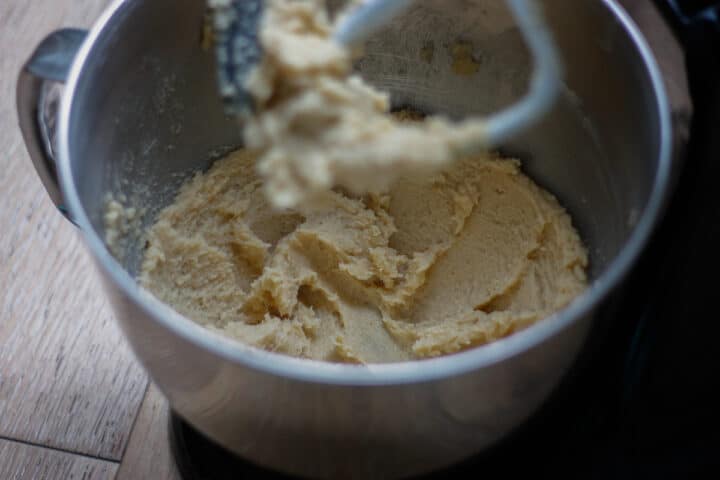
Add eggs gradually
Eggs are watery, the butter/sugar mix is high fat. Fat and water don't mix easily. We're trying to suspend the water in the egg into the fat (make an emulsion). We can help this process by taking it slow.
🥚Secrets of an 'egg-shell' crust
We aspire to get that crackly-looking crisp crust. We achieve this by vigorously whipping the creamed butter/sugar with the eggs. Then adding the rest of the ingredients.
Top of photo clockwise:
- whipped butter, sugar & eggs
- lined baking pan
- combined dry ingredients - flour, cocoa, baking powder, sugar & salt
- chopped chocolate
- melted chocolate
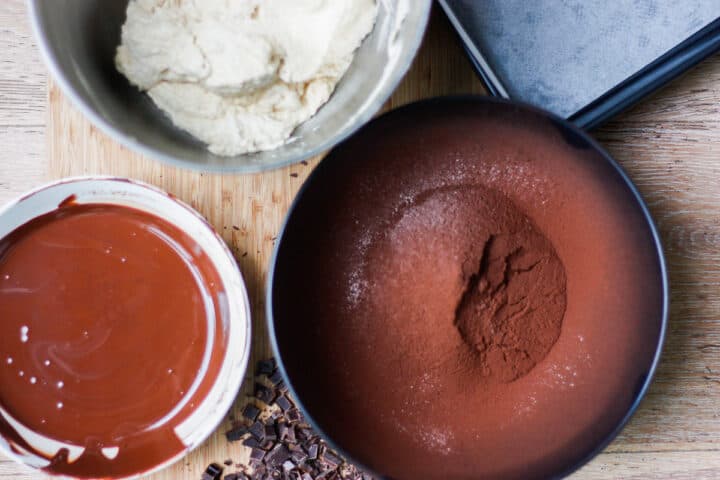
Don't overmix the batter
We spend time creaming the butter and sugar, and then the eggs into this. Once all the batter ingredients come together, we'll need a gentle but thorough touch. We need a bit of elbow grease to combine the wet and dry ingredients; this is quite a stiff batter. Keep going until the colour is quite uniform, with no yellowy streaks of butter. Do the minimum to achieve this though; we don't want to overwork our batter.
Combining the wet ingredients - beaten butter, sugar and eggs. We fold the melted chocolate through.
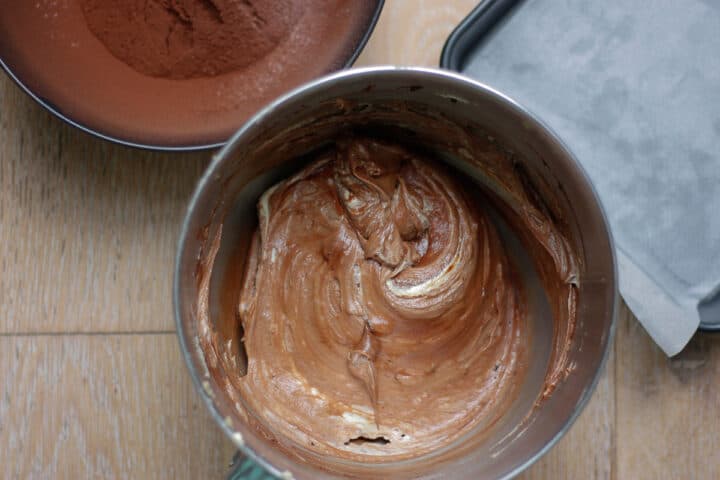
We add the chocolate chunks and then the dry ingredients. We fold together gently but thoroughly. Transfer the thick batter to the lined baking sheet and spread out.
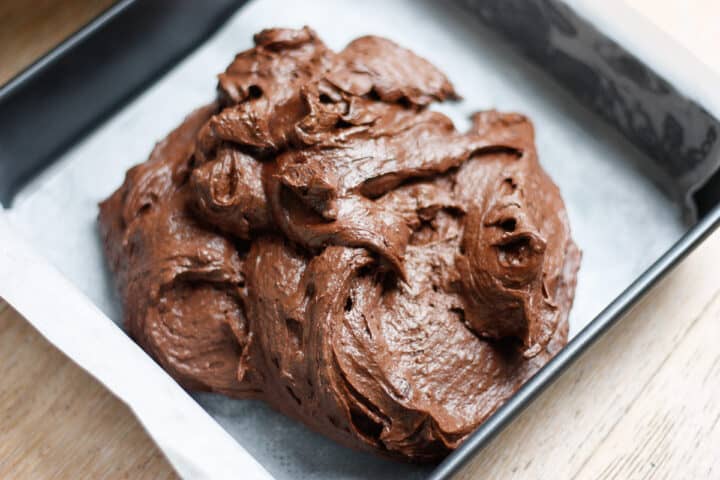
Bake for around 30 minutes.....
How do I know when my brownies are cooked?
Stick a toothpick diagonally through the brownie in the centre. Pull it out and inspect....is it:
- covered in clumps of raw batter? - the brownie is still undercooked. Put it back in the oven and retest in 3 minutes (set a timer!)
- a bit sticky with batter? - perfect! Stick the brownie pan in the iced water bath ASAP
- clean and dry? - it's sadly overcooked. It will be more of a chocolate cake. Still delicious, but not really a brownie
NB: If you don't have any toothpicks, use a fine wooden or metal skewer, a thin knife, an actual cake tester (!). Go for something as thin as possible - we don't want to disturb our beautiful egg-shell crust too much.
We set the brownie pan in cold water after baking
This rapidly cools down the brownie and halts the cooking. We want to maintain that perfection that you arrived at when you pulled it out of the oven. Using an ice bath might seem a bit of a faff, but it is easier than the alternative. Without it, we would need to undercook the brownie to allow for continued cooking after taking out of the oven. Quicker cooling means quicker slicing and eating anyway!
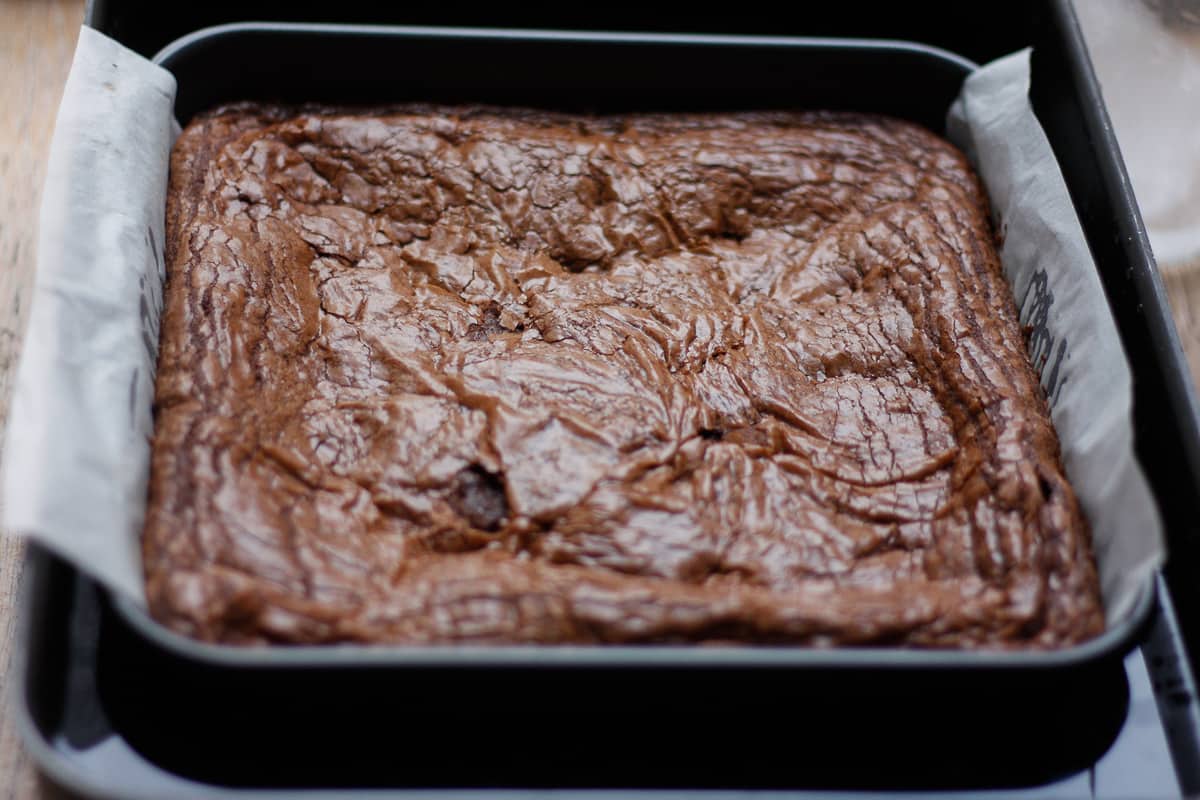
Removing the brownie from the tin
Run a butter knife along any edges of the brownie not surrounded by baking paper to loosen it from the tin edge. Grip a baking paper 'handle' in each hand and pull away from each other at the time time. This will both lift out the brownie and keep the base flat so that it doesn't buckle or crack
🔪 How do you cut brownies?
You spent the time and effort making delicious (and gorgeous) brownies? How on earth do you cut them so that they look consistent and profesh?
- wait for them to cool completely (and I mean completely)
- use a long serrated knife - don't cut with a sawing action, but push down gently
- give the knife a little wiggle side-to-side to separate the brownie slices either side. Pull out the knife with the blade along the board (not back up the way you came) - this will help keep the cuts neat
- wipe the knife blade between each cut. It will be covered with some gooey chocolate deliciousness). Spray with a neutral flavour vegetable oil (over the sink so it doesn't go everywhere!)
- try not to eat half of them as you do this 🤤
🤎 Serving suggestions
- nuke individual portions briefly (about 10 seconds) and serve with/through vanilla ice-cream
- eat straight from the freezer (these won't freeze SOLID)
- alternative celebration 'cake' - stack the brownies and dust with icing sugar. This makes a sophisticated, easy shareable dessert for those of you who 'don't like cake'
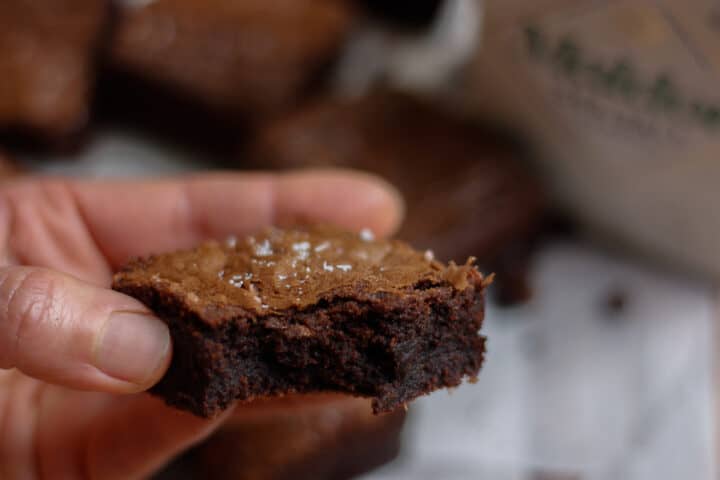
😋 Other chocolate delights
📖 Recipe
Equipment
- 23cm x 23cm baking pan for the brownies
- Larger baking pan (big enough to hold the brownie pan)
- Stand-mixer
Ingredients
- some softened butter (for greasing)
- 250 g chocolate (70% cocoa)
- 250 g unsalted butter
- 300 g golden caster sugar
- 4 eggs (3 whole eggs plus 1 yolk)
- 60 g plain flour
- ½ teaspoon baking powder
- Pinch salt
- 60 g unsweetened cocoa powder (Dutch process or natural)
Instructions
- Preheat Oven - to 160°C
- Prepare Pan - grease the pan generously with softened butter. Line across the base and up one set of opposite sides of your baking tin with a little overhang. This will enable you to gently lift out the cooked and cooled brownie.some softened butter
- Chocolate - break/chop 200g of the chocolate. Place in a shallow bowl. Gently melt in a microwave or bain-marie (see notes in the main post if you're not sure how to do this). Allow to cool slightly. Chop the remaining 50g chocolate into small chunks (no need to be precise) and keep separate for later.250 g chocolate
- Cream Butter & Sugar - put the sugar and softened butter in a stand mixer bowl. Using the beater attachment on a low setting, cream them together. You can increase to medium speed once combined. The mix will lighten in colour and get fluffy, which will take about 5 minutes. Stop every so often and use a silicone spatula to make sure everything's incorporated. Make sure you scrape the bottom of the bowl.250 g unsalted butter300 g golden caster sugar
- Eggs - whisk all the eggs together in a small bowl. While the mixer is still running, gradually drizzle in the eggs. Beat until each addition is well incorporated before adding more egg. Stop the mixer every so often and use a silicone spatula to scrape the sides and bottom. The batter will end up quite fluid. Once all the egg is in, leave it mixing at medium speed for 5 minutes. The batter will become light and fluffy and increased in volume. It might look a bit curdled if you've added the egg a bit fast. Don't worry if so, it will come good once you add the dry ingredients.4 eggs (3 whole eggs plus 1 yolk)
- Dry Ingredients - sift the flour, baking powder, salt and cocoa powder into a separate medium bowl. Use a hand whisk to combine if you can still see bits of white unincorporated flour.60 g plain flour½ teaspoon baking powderPinch salt60 g unsweetened cocoa powder
- Add Chocolate - remove the bowl from the stand-mixer. Add in both the melted and chunked chocolate and half the dry ingredients. Use a silicone spatula to fold everything through. You want to do this both gently and thoroughly. Once this is most incorporated, add the rest of the dry ingredients. The batter will seem really dry at first and like it will never come together. Keep at it, gently folding together until the mixture is a consistent chocolate colour with no pale streaks.
- Transfer to Pan - spoon dollops of the mixture into the tin and spread it around as evenly as you can. Create a thin ditch around the edge so that the outer part is at a slightly lower level than the inside.
- Bake - for 30 minutes, until a cake tester comes out sticky, but not coated in raw batter. If not quite done, keep testing at 3-minute intervals. Just before the 30-minutes is up, put a layer of ice cubes in the bottom of the larger baking pan, if you have.
- Cool Quickly & Completely - once cooked, place the whole brownie pan in the bigger baking tin. Pour cold water around the outside of the brownie pan. Don't come up too high! Remember that, if you have ice in your water, they're going to melt, and the level of the water will rise. Make sure no water gets inside. Allow the brownie to cool completely. Really carefully lift it out and transfer to a chopping board. It will have shrivelled up and sunk down a little. This is normal.
- Portion - take your time cutting into portions (note)
Notes
- wait for them to cool completely (and I mean completely)
- use a long serrated knife - don't cut with a sawing action, but push down gently
- give the knife a little wiggle side-to-side to separate the brownie slices either side. Pull out the knife with the blade along the board (not back up the way you came) - this will help keep the cuts neat
- wipe the knife blade between each cut. It will be covered with some gooey chocolate deliciousness). Spray with a neutral flavour vegetable oil (over the sink so it doesn't go everywhere!)



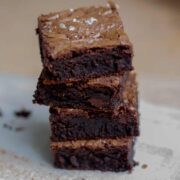


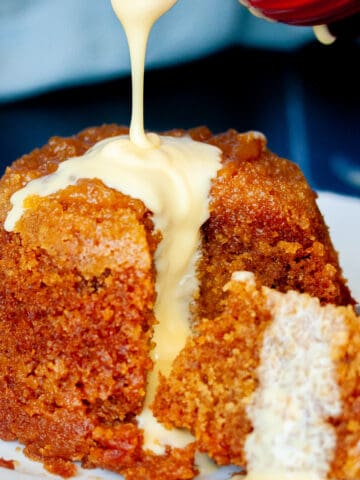
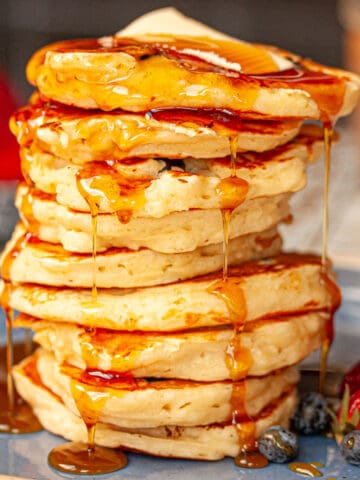
Comments